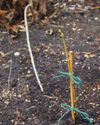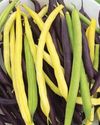
By July many of the early-planted vegetables in my garden are finished and it's time to get serious about succession planting.
Once a crop like spring turnips or snap peas has finished, I tidy up the bed, amend the soil with a thin layer of compost and replant. Depending on the new crop, I may be sowing seeds or transplanting seedlings.
Here are five tips to boost succession-planting success:
1 Pick the right crops. When planting in July, it's essential to select the right crops and varieties. This means choosing those that have time to grow and mature before your first fall frost date. Every variety has its "days to maturity" listed on the seed packet or in the seed catalog. With this information at hand, count backward from your first average frost date to know if a July planting will give the crop enough time to reach harvestable size.
2 Start certain crops indoors. Many gardeners turn their grow lights off once the garden has been planted out in spring. Not me! I continue to use my grow lights throughout summer to provide robust seedlings to pop into my garden beds.
3 Water frequently. July is typically the hottest month of the year and it can be difficult to keep the garden consistently damp. Yet it’s important to give just-planted beds and pots adequate moisture to avoid spotty sprouting or wilted seedlings. Using the mist or shower setting on your hose nozzle, water frequently. The ideal times for watering are the early morning and late afternoon.
Cucumbers.
4 Create shade over a seeded bed. To reduce watering, create shade over the bed by floating a piece of shade cloth or row cover on wire hoops. This slows water evaporation from the soil, so you won’t need to water as often. Once the seeds sprout, remove the shade so the young plants have plenty of sun.
Denne historien er fra July - August 2024-utgaven av Horticulture.
Start din 7-dagers gratis prøveperiode på Magzter GOLD for å få tilgang til tusenvis av utvalgte premiumhistorier og 9000+ magasiner og aviser.
Allerede abonnent ? Logg på
Denne historien er fra July - August 2024-utgaven av Horticulture.
Start din 7-dagers gratis prøveperiode på Magzter GOLD for å få tilgang til tusenvis av utvalgte premiumhistorier og 9000+ magasiner og aviser.
Allerede abonnent? Logg på

GAGA FOR GALANTHUS
As easy as they are irresistible, snowdrops boast a devoted and growing following

NEW PLANTS
Multiseason Marvels

BLUEBERRIES & CO.
Members of the genus Vaccinium provide sweet flavor, health benefits and beauty in the garden

AN ECOLOGICAL AGREEMENT
How three great minds think alike

Take It Indoors
Cs the growing season dwindles, _ potted cittus became a summer souuenir

ROOTED IN PLACE
LAYERING IS A PROPAGATION TECHNIQUE THAT TAKES A WHILE TO COMPLETE, BUT IT DEMANDS LITTLE EFFORT FROM THE GARDENER

AT HOME WITH PLANTS
Business travel and pleasure trips helped inspire this Cincinnati garden

THE GARDEN GOES DARK
Yes, gardens have their dark side. But-surprise! A garden's darkness can be good, not sinister.

LOW-WATER WONDERS
EXPLORE ONE PLANTSMAN'S DROUGHT-TOLERANT FAVORITES FOR EACH LEVEL OF THE GARDEN

Succeed With Succession- The best crops to plant throughout summer, plus how to time them right
The best crops to plant throughout summer, plus how to time them right. Once a crop like spring turnips or snap peas has finished, I tidy up the bed, amend the soil with a thin layer of compost and replant. Depending on the new crop, I may be sowing seeds or transplanting seedlings.